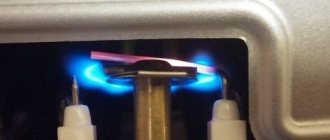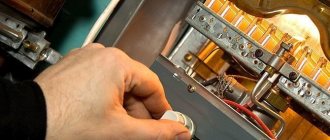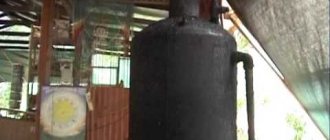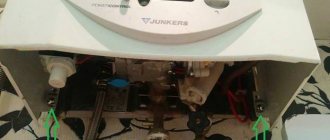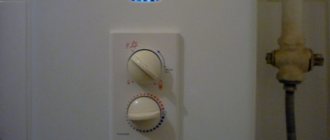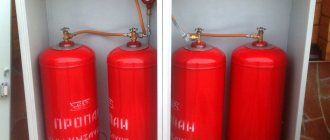Why does the gas water heater turn off? Ignition and instantaneous extinction
Why does the gas water heater go out? The geyser lights up and goes out - reasons
Why does the gas water heater turn on and immediately go out? You can do the following if the speaker goes out immediately after turning on:
- Examine the igniter. Are there any extraneous sounds during operation?
- Monitor how long it takes for the damping to occur.
A breakdown of the ionization sensor is the first cause of this problem. This element is responsible for ensuring that the burner has a flame. There are several ways to understand that the problem is with this component:
- The burner goes out 3-5 seconds after ignition.
- Restarting takes longer.
- The equipment begins to function normally after several starts.
- The problems recur after a short period of interruption.
The owner is required to inspect the wiring that is connected from the sensor to the control board. If it is in order, the part most likely needs to be replaced.
The geyser goes out: causes and repairs
If the distribution block is faulty, then the geyser will not respond to the supply of gas, or to the ignition of the pilot, in general, it will remain sternly silent. In this case, the distribution block must be replaced.
Let us remind you that the igniter is designed to ignite the main combustion system when water is supplied. The flame occurs as a result of the combustion of a warm air mixture. The igniter heats the thermocouple by physically reaching the main burner.
Well, it also makes sense to climb onto the roof and see what’s wrong with your chimney, in case your neighbors installed something there and blocked it for you (for example, a television antenna, or even a dish).
If the wick fires and goes out after about a minute, it can be stated that the gas control safety system has been activated.
Faulty ignition system
This means that a sensor that reacts to combustion products is working. There are so many of them that they simply cannot be removed from the system.
- Clogged with debris, soot, and soot.
Because of this, there is no normal traction, waste simply is not removed outside. Then the owner just needs to clean the hole on his part. If this does not help, you will have to call representatives of utility services. They will help you understand why geysers turn off.
- Powerful ventilation working nearby.
Because of this, the waste is drawn into the ventilation hole. It is recommended to turn off the ventilation while the speaker is operating. Or you need to set the minimum power.
- Heat exchanger clogged.
In this case, during operation, soot, soot, and scale are deposited on the internal surfaces. Because of this, the color of the flame begins to change. It turns not blue, but yellow. Then you will need to remove the casing, unscrew the heat exchanger mount, and clean the structure.
- In the absence of ventilation.
Insufficient pressure
It often happens that the speakers light up, continue to work for a while, and then turn off.
- The first recommendation is to check the settings thoroughly. Perhaps the user himself chose the option to automatically turn off after some time.
- Another reason is an increase in temperature to 100 degrees or more. In this case, the temperature sensor is triggered and prevents further operation.
- Problems may arise due to poor pressure in the water or gas pipeline.
- Another possible reason is poor contact between the thermocouple and the solenoid valve.
In the latter case, simply cleaning the contact area is sufficient. The connections are further tightened.
There are other possible reasons why the gas water heater turns off.
- Oxidation of power supply contacts.
In this case, the device clicks, but the wick simply does not light up. The contacts require cleaning.
- Dead batteries.
It is recommended to replace these parts every six months. It is better to choose powerful batteries that can maintain a charge level for a maximum time.
Causes of malfunction of a gas-powered water heater
There are many reasons why certain complaints about speakers arise.
In a situation where
the gas water heater smokes, goes out or does not light up you can try to fix the problem on your own, but the best outcome would be to call a technician.
Let's take a closer look at the possible causes of geyser malfunctions.
Impossibility of igniting the igniter (wick)
Most often, this phenomenon occurs in gas water heaters. There are two reasons why the igniter does not fire:
- If there is no draft in the chimney, the electronic control system shuts off the gas supply.
A lack of draft indicates the need to clean the chimney, which can be clogged with soot and dust, or various debris, including construction debris. It is also necessary to make sure that craftsmen have not installed television antennas or other structures above the chimney on the roof, which in itself is a violation of safety regulations.
- Damage to the piezoelectric element is characterized by the absence of an ignition spark. Quite often there are models of geysers whose ignition systems are powered by simple batteries. In this case, to eliminate the problem, you should try replacing the batteries.
Many owners of gas water heaters (Junkers) equipped with piezo ignition often encounter the problem of igniting the igniter.
Short-term burning of a lit igniter followed by its extinction
The situation when the wick burns, but soon goes out, arises due to the fact that:
- The gas regulator is not held down long enough. The minimum pressing time is 10 seconds. During this time, gas is forced into the system, and the wick begins to warm up. An automatic control system monitors the temperature at the igniter - when it cools down, the gas supply is cut off.
- For normal functioning of the igniter, a certain draft is required. A clogged chimney and a littered ventilation system interfere with air flow. The triggered protection system stops the gas supply. Tightly closed windows that block the flow of air into the room also cause the reaction of the protective relay.
- Too strong an air draft, on the contrary, can “blow out” the igniter. Thus, a draft from open windows provokes extinguishing of the wick.
Owners of most units and Oasis may encounter this problem.
The unit does not turn on when the wick lights up
Sometimes, a burning igniter does not guarantee that the device is in operation:
- Lack of draft does not allow combustion products to be removed in full, which causes the automatic gas supply protection system to shut off.
- Errors in the supply of water supply pipes affect the fact that the automatic water heater does not allow it to turn on in order to avoid more serious damage.
- Low water pressure in the pipes or complete lack of water supply.
- The filters installed on the faucet and on the water supply pipe to the unit are clogged with rust, small stones and sand, and scale. In this case, the filter requires thorough cleaning or replacement.
- The membrane installed in the device is damaged and requires replacement. The features of this process depend on the manufacturer and model of the geyser.
A short period of operation of the gas water heater followed by shutdown
Attenuation of the wick sometimes occurs after some time of normal operation of the water heating device, which is provoked by the following reasons:
- weak air draft;
- in rare cases, the emergency relay, which is responsible for protecting the device from explosion, can be too sensitive to even the slightest decrease in thrust.
The device lights up, functions, but smokes
Soot settling inside the parts of the gas water heater provokes the appearance of soot during its operation.
In this case, the device must be disassembled and thoroughly cleaned and washed.
The rapid restoration of soot in parts is provoked by too low draft force in the chimney - it is worth taking care of cleaning the chimney itself, and then again rinsing
all components and parts from combustion products.
Work principles
A thermocouple is two welded conductors. One is made of alumel and chromel. The thermocouple has one main function - supplying power to the solenoid valve.
Such a part rarely fails. At the exit from the housing there is a bottleneck equipped with a central conductor. The latter is equipped with high-quality insulation, but even it sometimes gets worn out, causing the speakers to go out.
Another problem is contact failure at the thermocouple welding points. In this case, it is impossible to restore the original characteristics. After all, the current generator passes through the same place. It is recommended to purchase a replacement for the old part.
A solenoid valve is also known as a copper wire coil. Inside this structure there are metal cylinders called a solenoid. There is a mechanical connection between this part and the shut-off valve for gas to enter the burner.
How does a gas water heater work?
Two main elements are responsible for heating the water in the column:
- gas-burner;
- the heat exchanger, which is located above it, is a spiral tube through which heated water passes.
The rest of the gas apparatus consists of the following components:
- Ignition. In “prehistoric” Soviet models, this role was played by a wick or igniter, which was lit with a match. Now a piezoelectric element is responsible for this, which only requires the user to press a certain button.
- Water-gas device. Its elements are a gas valve and a membrane installed in the water supply. When you open the water, it starts moving through the column. Due to the water flow, the membrane bends, opening the gas valve, allowing gas to be supplied to the burner.
- The safety automation includes a solenoid valve to which sensors are connected to monitor the uninterrupted operation of the device. If any problems are detected, the sensors instantly close the valve and the column stops working. If we are talking about devices with igniters, then a thermocouple is also attached to the valve, which is heated by the flame. When the burner goes out, it fires.
How to prevent breakdown?
Preventing igniter problems
The best way out when detecting problems with the igniter is to contact a specialist with a sufficient level of qualifications.
The main thing is to have an official license that allows you to work with gas equipment.
It checks all nodes that could become a source of trouble. And it takes into account the nuances characteristic of a particular type of equipment.
The user himself can only check the traction until emergency service representatives appear on the spot.
To do this, just light a match and bring it to the viewing window. If the flame is drawn inward, it means there is draft and it is sufficient. The chimney pipe is disconnected when there is no movement. Near the opening of the ventilation shafts, the movement with the match is repeated.
Problems with gas leaks are the most serious and complex. It is easy to identify by the presence of a characteristic odor. In this case, you definitely shouldn’t risk trying to fix the problem yourself.
It is better to turn off the gas, ventilate the room, and then call the utility services. Only in this case there is no need to be afraid.
Why does the gas water heater light up and go out, what should I do? The column lights up and immediately goes out - troubleshooting:
See also Phone numbers for consultation July 30, 2021 kasjanenko 862
Share this post
Discussion: there is 1 comment
- Lara says:
10/03/2018 at 00:47The gas water heater requires due attention and you should still be aware that if handled incorrectly, it can explode. I think it's better to call the gas service and sort out the problems.
Answer
